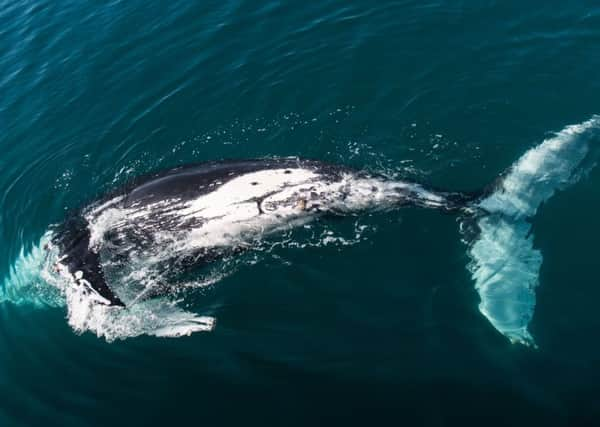Travel review: Controversial new swim with whales experience on Australia's east coast


Stretched taut like delicate fabric on an embroidery frame, there’s not even a wrinkle in the Coral Sea below me. Weather conditions are ideal for a light aircraft flight across the Great Barrier Reef, where spiralling threads create one of nature’s greatest designs.
But as I head towards my destination, Hervey Bay, in southern Queensland, I realise I’m not the only traveller. Below, a procession of sea-salt plumes chugs purposefully northward, part of an epic annual migration of humpback whales.
Advertisement
Hide AdAdvertisement
Hide AdFrom the end of July until mid-October, thousands leave their feeding grounds in Antarctica in search of warmer waters to calve. It’s a phenomenon that’s been happening for centuries, although a short-lived but decimating whaling industry reduced numbers to just 150 in the 1960s.
Yet today, Australia’s east coast humpback population is booming, with an estimated 30,000 annually visiting the Barrier Reef. It’s one of the few positive stories to emerge from the beleaguered region, currently grappling with the damaging effects of climate change.
While whales can be seen along the coastline, one of the best places to observe their behaviour is Hervey Bay, a shallow body of water buffered by Fraser Island – the largest sand island in the world.
Chatter-filled, open-front cafes and informal seafood restaurants line a long esplanade, although most of the whale-watching action is centred around the Great Sandy Straits Marina, where my hotel, Mantra Hervey Bay, is a five-minute walk from the jetty – convenient for 7am tour departures.
Advertisement
Hide AdAdvertisement
Hide AdI join skipper Peter Lynch on his sailing catamaran Blue Dolphin. Carrying just 20 passengers, the full-day trips are intimate and travel at a much slower pace than other whale watching boats. By lowering a platform into the water, Peter offers an “immersion experience” with the whales.
“So far, we’ve not been able to get in the water very often,” he tells me. Stringent restrictions, including the need for guests to have feet already in the water while the whales are still at a minimum 100m distance, are proving challenging.
There may be no chance of getting my toes wet today, but there are plenty of other distractions to keep me entertained. Within 45 minutes of leaving the harbour, I’ve seen all manner of acrobatic tail flukes, furious peduncle throws and energetic games of tag with porpoising dolphins. It’s no wonder Hervey Bay has passed the first stage in being named a Whale Heritage site.
My second stab at snorkelling with cetaceans comes on a trip with Hervey Bay Whale Watch on their speedy Quick Cat II. There’s a chance to swim with whales on every trip if the conditions are suitable (costing an additional $95AUS/£57, payable only if you actually get in the water) and so far they’ve had a 50 per cent success rate.
Advertisement
Hide AdAdvertisement
Hide AdOur voyage gets off to a slow start. Most of the whales we pass are snoozing, suspended on the surface like yogis. But when two curious individuals start circling the boat, I wonder if this might be my chance to join their underwater dance. After three laps, Sam is convinced these are indeed “the right whales” and we scramble into our swimsuits.
Six people at a time are tied to a rope attached to the boat, and in a flurry of excitement we quickly become knotted in a tangle of arms and legs. A rousing symphony blares from two large speakers (whales apparently respond better to sound), followed by cheers and applause from the on-deck audience as our headline stars glide into the limelight.
Despite poor visibility in the silty water, the outline of two giant white-bellied, pec-arching angels is unmistakable. Intrigued by his new playmates, one pops his barnacled head gently above the surface – another spins slowly beneath us like a propeller plane in slow motion free fall.
“This is the most amazing thing that’s ever happened to me!” squeals one girl through her snorkel. No-one can be certain the whales share her sentiments, although the fact they stick around for a remarkable 30 minutes suggests they must be having fun.
Advertisement
Hide AdAdvertisement
Hide AdNot everyone, though, is so enthusiastic about the experience. “Trish and I are strongly opposed to the programme,” says Dr Wally Franklin, who has been studying Australia’s east coast whale population since 1989. He bases his decision partly on the risk factor involved in swimming with such large and powerful wild animals.
But does any form of whale tourism potentially disturb or alter the whales’ behaviour? On that issue, Wally doesn’t seem too concerned.
“Whales evolved to their present form between 12 and 23 million years ago,” he says. “They’ve been able to adapt to incredible changes, whereas we’re not showing a lot of capability in our rather short lives.”
Those word echo around my head as our whales bid farewell with a final flick of their flukes. Like Wally says, chances are they’ll still be here when we’re long gone.
GETTING THERE
Advertisement
Hide AdAdvertisement
Hide AdFor more information on the destination, visit australia.com and queensland.com.
Mantra Hervey Bay (mantraherveybay.com.au) offers room-only accommodation from £108 per night for two adults.
Hervey Bay Whale Watch (herveybaywhalewatch.com.au) operates half-day whale watching tours from £63; Blue Dolphin Marine Tours (bluedolphintours.com.au) operate full-day day trips from £90.
Qantas (quantas.com) offers flights from Heathrow to Brisbane from £700 per person.